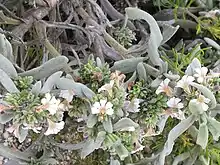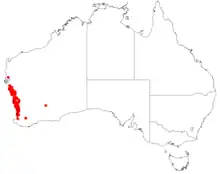| Scaevola canescens | |
|---|---|
 | |
| Scaevola canescens | |
| Scientific classification | |
| Kingdom: | Plantae |
| Clade: | Tracheophytes |
| Clade: | Angiosperms |
| Clade: | Eudicots |
| Clade: | Asterids |
| Order: | Asterales |
| Family: | Goodeniaceae |
| Genus: | Scaevola |
| Species: | S. canescens |
| Binomial name | |
| Scaevola canescens | |
 | |
| Occurrence data from AVH | |
| Synonyms[3] | |
|
Dampiera canescens (Benth.) de Vriese | |
Scaevola canescens is a species of plant in the family Goodeniaceae. It is endemic to Western Australia where it occurs "from Shark Bay to Perth, in open forest and heath in sandy soil".[1]
Description
Scaevola canescens (grey scaevola)[4] is a shrub growing up to 60 centimetres (24 in) high.[1] It has sessile, entire, oblong to oblanceolate leaves which are 12–85 millimetres (0.47–3.35 in) long and 4–15 millimetres (0.16–0.59 in) wide[1] and densely hairy.[4] It flowers from March to October[4] in axillary spikes up to 10 centimetres (3.9 in) long, the corolla is bearded, and white with brownish veins.[1] The fruit is usually one-seeded.[1]
Distribution
It grows in the IBRA regions: Avon Wheatbelt, Geraldton Sandplains, Jarrah Forest, Swan Coastal Plain, and Yalgoo.
Etymology
The specific epithet is Latin:
canescens,-entis (part.B): canescent, “grayish-white. A term applied to hairy surfaces” (Lindley[5]); “hoary with gray pubescence” (Fernald 1950[6]); becoming gray, grayish; in mosses, hoary due to the collective hyaline hair points on the apices of leaves.[7]
Taxonomy
S. canescens was first described by George Bentham in 1837.[2] A holotype (W0047196) was collected by von Hügel at King Georges Sound, and is kept at Naturhistorisches Museum Wien Botanische Abteilung (W).[8] The earliest Australian record (MEL 1521288A) was collected by J.A.L. Preiss on April 15, 1839, somewhere in the vicinity of Perth.[9]
References
- 1 2 3 4 5 6 Carolin, R.C. (1992). "Scaevola canescens". ABRS Flora of Australia. Data derived from Flora of Australia Volume 35. Retrieved 23 June 2018.
- 1 2 Bentham, G. 1837. in Endlicher, S.F.L., Fenzl, E., Bentham, G. & Schott, H.W. Enumeratio plantarum quas in Novae Hollandiae ora austro-occidentali ad Fluvium Cygnorum et in Sinu Regis Georgii collegit Carolus liber baro de Hügel, p. 69
- ↑ Govaerts, R.; et al. "Scaevola canescens". Plants of the World online. Board of Trustees of the Royal Botanic Gardens, Kew. Retrieved 23 June 2018.
- 1 2 3 "Scaevola canescens". FloraBase. Western Australian Herbarium, Biodiversity and Conservation Science, Department of Biodiversity, Conservation and Attractions. Retrieved 23 June 2018.
- ↑ Lindley, J. 1849. ed. 6. The Elements of Botany, Structural, Physiological, & Medical: Being a 6th Ed. of the Outline of the First Principles of Botany, with a Sketch of the Artificial Methods of Classification, and a Glossary of Technical Terms.
- ↑ Fernald, M.L. (revised). 1950. Gray's Manual of Botany. Ed. 8. American Book Co., New York.
- ↑ Eckel, P.M. "A Grammatical Dictionary of Botanical Latin". Missouri Botanical Garden. Retrieved 24 June 2018.
- ↑ "JSTOR Global Plants: Holotype of Scaevola canescens Benth". Retrieved 25 June 2018.
{{cite journal}}: Cite journal requires|journal=(help) - ↑ "Occurrence record: MEL 1521288A". AVH The Australasian Virtual Herbarium.